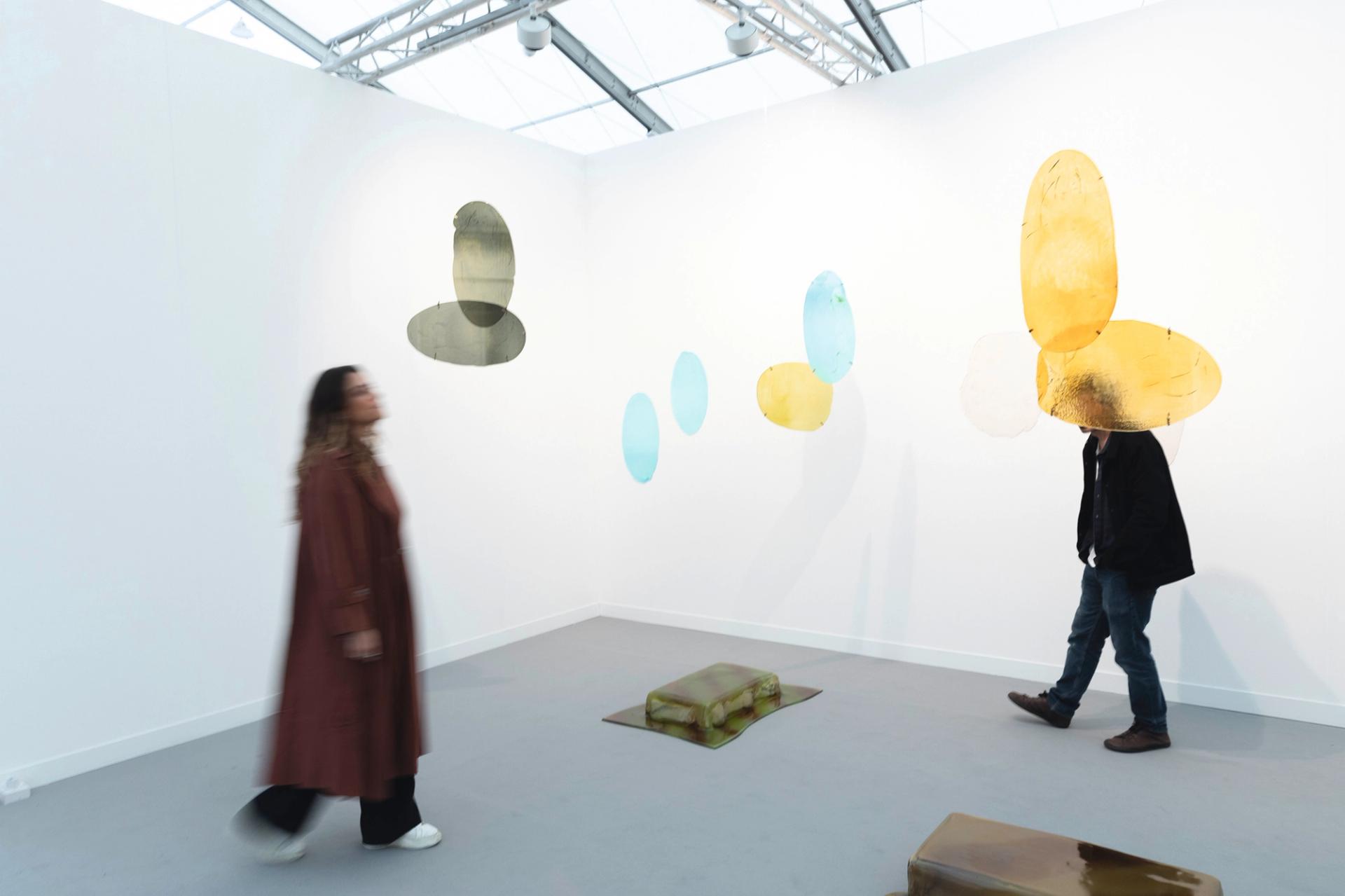stand-out galleries from this year’s Focus section at Frieze London

As ever, the fair’s Focus section features presentations by galleries that have operated for 12 years or less. The latest edition features 34 galleries from 18 countries. A striking aspect of this year’s Focus is the quality and dynamism of emerging galleries in London. Two recent reliable staples from the UK capital have been Emalin and Union Pacific, which are now promoted to the main section of Frieze, and in their wake are similarly impressive new spaces. It is no surprise, then, that in its first ever presentation at the fair, East London’s Public Gallery won the Focus Stand Prize and sold work by Adam Farah-Saad’s work to the Tate.
Adam Farah-Saad, Public Gallery

Farah-Saad is a self-described psychogeographer and this stand is a paean to London and his personal experiences here. A working CD listening-post with albums by Janet Jackson and Mariah Carey, among others, and a burgundy dado rail around the stand are references to childhood sounds and interiors. KA Black Grape fizzy drink, a hallmark of urban teenage life, pumps from a circular drinking fountain inspired by the one in the public toilets of a north London shopping centre, which is a gay cruising spot. Wind chimes with hanging bottles of poppers and bodily photographic images set in sauna-like tongue-and-groove wood frames are among other queer references.
Laurence Sturla, Gianni Manhattan

Born in Swindon, 60 miles west of London, but now based in Vienna, Sturla here presents salt-encrusted ceramic forms, redolent of fractured bodies or battered landscapes, sitting on PVC-covered plinths. At the start of the fair, the plinths contained shallow pools of salted water, which are now drying up, leaving a crystallised surface. Akin to recently dug-up archaeological specimens, they allude to an ancient source: Sappho’s fragmented poetry as translated by the Canadian classicist and poet Anne Carson. The absences in Sappho’s largely lost texts are evoked in the negative spaces of Sturla’s forms.
Marija Olšaskaitė, PM8 / Francisco Salas

An oasis of quiet reflection, PM8 / Francisco Salas’s stand features two bodies of work by Olšaskaitė in glass. A group of thin, fragile ovals hang over the stand and adorn its walls. They are called Budinti, meaning watcher or overseer. The hanging pieces have faint drawn outlines of female forms, while those on the walls are entirely abstract. On the floor are three works called Benches, which evoke boxes covered in textiles, but also seem to be caught between solid and liquid states, as if melting. The glass is repurposed from old factories from the Soviet era, lending further poeticism to Olšaskaitė’s lyrical endeavour.
Mattia Guarnera-MacCarthy andHamed Maiye, Harlesden High Street

The velvet curtains and stage here are based on The Junior Christian Teaching Bible Lesson Show, a US TV programme with puppets. The host, David Liebe Hart, is giving performances at Frieze every day at 5pm. Around him are paintings by Mattia Guarnera-MacCarthy and Hamed Maiye, whose figurative imagery explores religious symbols: Guarnera-MacCarthy’s spectral images of young Black people, including a boy with a hallucinatory rosary, and Maiye’s close-ups on parts of figures with religious adornment in the form of jewellery or tattoos. The two artists have collaborated on a portrait of Liebe Hart with a puppet, Chip.
Sophie Thun, Sophie Tappeiner

Thun’s practice is essentially about her medium: analogue photography. But this is not dry self-reflexiveness; rather, a playful and performance-driven exploration of making images, with Thun’s own body at its heart. Based on a piece made recently in Ljubljana, the Frieze presentation consists of framed photographs with photograms of Thun’s hands and vast wall-covering images that create photographic architectures. In one of the latter, Thun, apparently naked and sexually prone, appears twice, with a shutter release cable in her hand: the artist trapping herself in a game of overlaps and illusions.
Fátima Rodrigo and Sandra Gamarra, 80M2 Livia Benavides

Two Lima-based artists working in very different languages, but each bringing a critical eye to how Latin American and indigenous cultures have been used and exploited in the Global North. Sandra Gamarra’s Imágenes crocantes sobre un ambiente húmedo works take Josef Albers’s Homage to the Square series, influenced by ancient Latin American forms, and reimbues them with portraits of indigenous Peruvians. In Fátima Rodrigo’s wall-hanging textiles and sculptures—including gloves adorned with gems, representations of snakes and eyes—she references the commercial exploitation of Andean culture in Western fashion imagery.
Source link





